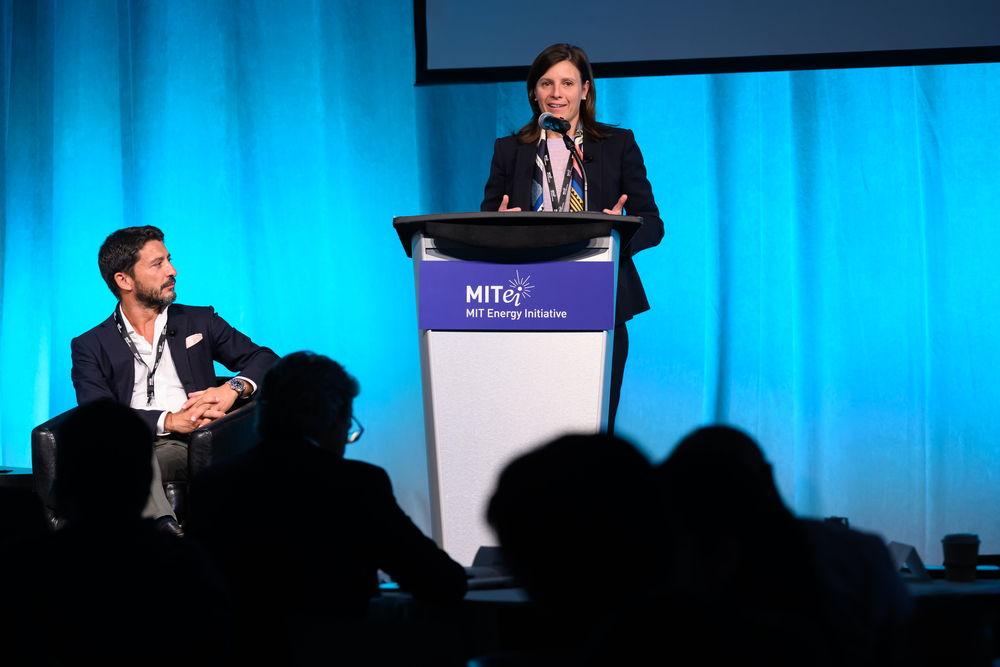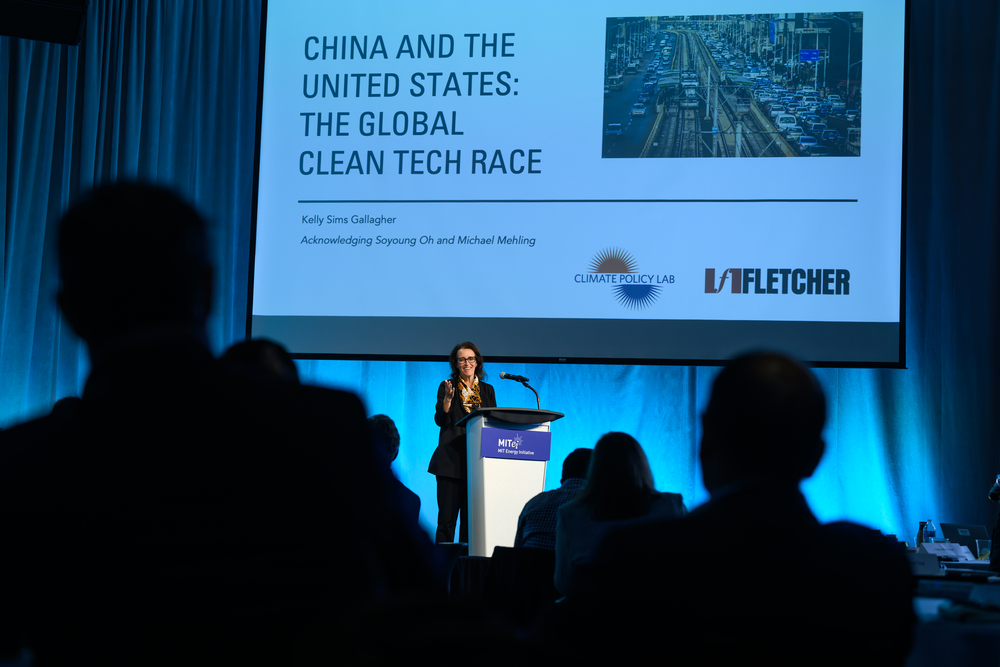
“We’re here to talk about really substantive changes, and we want you to be a participant in that,” said Desirée Plata, the School of Engineering Distinguished Professor of Climate and Energy in MIT’s Department of Civil and Environmental Engineering, at Energizing@MIT: the MIT Energy Initiative’s (MITEI) Annual Research Conference that was held on September 9-10.
Plata’s words resonated with the 150-plus participants from academia, industry, and government meeting in Cambridge for the conference, whose theme was “tackling emerging energy challenges.” Meeting such challenges and ultimately altering the trajectory of global climate outcomes requires partnerships, speakers agreed.
“We have to be humble and open,” said Giacomo Silvestri, chairman of Eniverse Ventures at Eni, in a shared keynote address. “We cannot develop innovation just focusing on ourselves and our competencies…so we need to partner with startups, venture funds, universities like MIT and other public and private institutions.”
Added his Eni colleague, Annalisa Muccioli, head of research and technology, “The energy transition is a race we can win only by combining mature solutions ready to deploy, together with emerging technologies that still require acceleration and risk management.”

Annalise Muccioli (right) and Giacomo Silvestri, both of Eni SpA, presented the opening keynote address on Eni’s strategic response to emerging energy challenges. Credit: Gretchen Ertl
Research targets
In a conference that showcased a suite of research priorities MITEI has identified as central to ensuring a low-carbon energy future, participants shared both promising discoveries and strategies for advancing proven technologies in the face of shifting political winds and policy uncertainties.
One panel focused on grid resiliency—a topic that has moved from the periphery to the center of energy discourse as climate-driven disruptions, cyber threats, and the integration of renewables challenge legacy systems. A dramatic case in point: the April 2025 outage in Spain and Portugal that left millions without power for eight to 15 hours.
“I want to emphasize that this failure was about more than the power system,” said MITEI research scientist Pablo Duenas-Martinez. While he pinpointed technical problems with reactive power and voltage control behind the system collapse, Duenas-Martinez also called out a lack of transmission capacity with Central Europe and out-of-date operating procedures and recommended better preparation and communication among transmission systems and utility operators.
“You can’t plan for every single eventuality, which means we need to broaden the portfolio of extreme events we prepare for,” noted Jennifer Pearce, vice president at energy company Avangrid. “We are making the system smarter, stronger, and more resilient to better protect from a wide range of threats such as storms, flooding, and extreme heat events.” Pearce noted that Avangrid’s commitment to deliver safe, reliable power to its customers necessitates “meticulous emergency planning procedures.”
The resiliency of the electric grid under greatly increased demand is an important motivation behind MITEI’s September 2025 launch of the Data Center Power Forum, which was also announced during the annual research conference. The Forum will include research projects, webinars, and other content focused on energy supply and storage, grid design and management, infrastructure, and public and economic policy related to data centers. The Forum’s members include MITEI companies that also participate in MIT’s Center for Environmental and Energy Policy Research (CEEPR).
Storage and transportation: Staggering challenges
Meeting climate goals to decarbonize the world by 2050 requires building around 300 terawatt hours of storage, according to Asegun Henry, a professor in the MIT Department of Mechanical Engineering. “It’s an unbelievably enormous problem people have to wrap their minds around,” he said. Henry has been developing a high-temperature thermal energy storage system he has nicknamed “sun in a box.” His system uses liquid metal and graphite to hold electricity as heat and then convert it back to electricity, enabling storage anywhere from five to 500 hours.
“At the end of the day, storage provides a service, and the type of technology that you need is a function of the service that you value the most,” said Nestor Sepulveda, commercial lead for advanced energy investments and partnerships at Google. “I don’t think there is one winner takes all type of market here.”
Another panel explored sustainable fuels that could help decarbonize hard-to-electrify sectors like aviation, shipping, and long-haul trucking. Randall Field, MITEI’s director of research, noted that sustainably produced drop-in fuels—fuels that are largely compatible with existing engines—“could eliminate potentially trillions of dollars of cost for fleet replacement and for infrastructure build out, while also helping us to accelerate the rate of decarbonization of the transportation sectors.”
Erik G. Birkerts is the chief growth officer of LanzaJet, which produces a drop-in, high-energy-density aviation fuel derived from agricultural residue and other waste carbon sources. “The key to driving broad sustainable aviation fuel adoption is solving both the supply-side challenge through more production and the demand-side hurdle by reducing costs,” he said.
“We think a good policy framework [for sustainable fuels] would be something that is technology neutral, does not exclude any pathways to produce, is based on life cycle accounting practices, and on market mechanisms,” said Veronica L. Robertson, energy products technology portfolio manager at ExxonMobil.
MITEI plans a major expansion of its research on sustainable fuels, announcing a two-year study, “The future of fuels: Pathways to sustainable transportation,” starting in early 2026. According to Field, the study will analyze and assess biofuels and e-fuels.
Solutions from labs big and small
Global energy leaders offered glimpses of their research projects. A panel on carbon capture in power generation featured three takes on the topic: Devin Shaw, commercial director of decarbonization technologies at Shell, described post-combustion carbon capture in power plants using steam for heat recovery; Jan Marsh, a global program lead at Siemens Energy, discussed deploying novel materials to capture CO₂ directly from the air; and Jeffrey Goldmeer, senior director of technology strategy at GE Vernova, explained integrating carbon capture into gas-powered turbine systems.
During a panel on vehicle electrification, Brian Storey, vice president of energy and materials at the Toyota Research Institute, provided an overview of Toyota’s portfolio of projects for decarbonization, including solid-state batteries, flexible manufacturing lines, and grid-forming inverters to support EV charging infrastructure.
A session on MITEI seed fund projects revealed promising early-stage research inside MIT’s own labs. A new process for decarbonizing the production of ethylene was presented by Yogesh Surendranath, Donner Professor of Science in the MIT Department of Chemistry. Materials Science and Engineering Assistant Professor Aristide Gumyusenge also discussed the development of polymers essential for a new kind of sodium-ion battery.
Shepherding bold, new technologies like these from academic labs into the real world cannot succeed without ample support and deft management. A panel on paths to commercialization featured the work of Iwnetim Abate, Chipman Career Development Professor and Assistant Professor in the MIT Department of Materials Science and Engineering, who has spun out a company, Addis Energy, based on a novel geothermal process for harvesting clean hydrogen and ammonia from subsurface, iron-rich rocks. Among his funders, ARPA-E and MIT’s own The Engine Ventures.
The panel also highlighted the MIT Proto Ventures Program, an initiative to seize early-stage MIT ideas and unleash them as world-changing startups. “A mere 4.2% of all the patents that are actually prosecuted in the world are ever commercialized, which seems like a shocking number,” said Andrew Inglis, an entrepreneur working with Proto Ventures to translate geothermal discoveries into businesses. “Can’t we do this better? Let’s do this better!”

Kelly Sims Gallagher, dean of the Fletcher School at Tufts University and an expert on China’s energy landscape, addresses the global clean tech race between China and the United States in her keynote. Credit: Gretchen Ertl
Geopolitical hazards
Throughout the conference, participants often voiced concern about the impacts of competition between the United States and China. Kelly Sims Gallagher, dean of the Fletcher School at Tufts University and an expert on China’s energy landscape, delivered the sobering news in her keynote address: “U.S. competitiveness in low-carbon technologies has eroded in nearly every category,” she said. “The Chinese are winning the clean tech race.”
China enjoys a 51% share in global wind turbine manufacture and 75% in solar modules. It also controls low-carbon supply chains that much of the world depends on. “China is getting so dominant that nobody can carve out a comparative advantage in anything,” said Gallagher. “China is just so big, and the scale is so huge that the Chinese can truly conquer markets and make it very hard for potential competitors to find a way in.”
And for the United States, the problem is “the seesaw of energy policy,” she says. “It’s incredibly difficult for the private sector to plan and to operate, given the lack of predictability and policy here.”
Nevertheless, Gallagher believes the United States still has a chance of at least regaining competitiveness, by setting up a stable, bipartisan energy policy, rebuilding domestic manufacturing and supply chains; providing consistent fiscal incentives; attracting and retaining global talent; and fostering international collaboration.
The conference shone a light on one such collaboration: a China-U.S. joint venture to manufacture lithium iron phosphate (LFP) batteries for commercial vehicles in the United States. The venture brings together Eve Energy, a Chinese battery technology and manufacturing company; Daimler, a global commercial vehicle manufacturer; PACCAR, Inc., a U.S.-based truck manufacturer; and Accelera, the zero-emissions business of Cummins Inc. “Manufacturing batteries in the U.S. makes the supply chain more robust and reduces geopolitical risks,” said Mike Gerty, of PACCAR.
While she acknowledged the obstacles confronting her colleagues in the room, Plata, nevertheless concluded her remarks as a panel moderator with some optimism: “I hope you all leave this conference and look back on it in the future, saying I was in the room when they actually solved some of the challenges standing between now and the future that we all wish to manifest.”